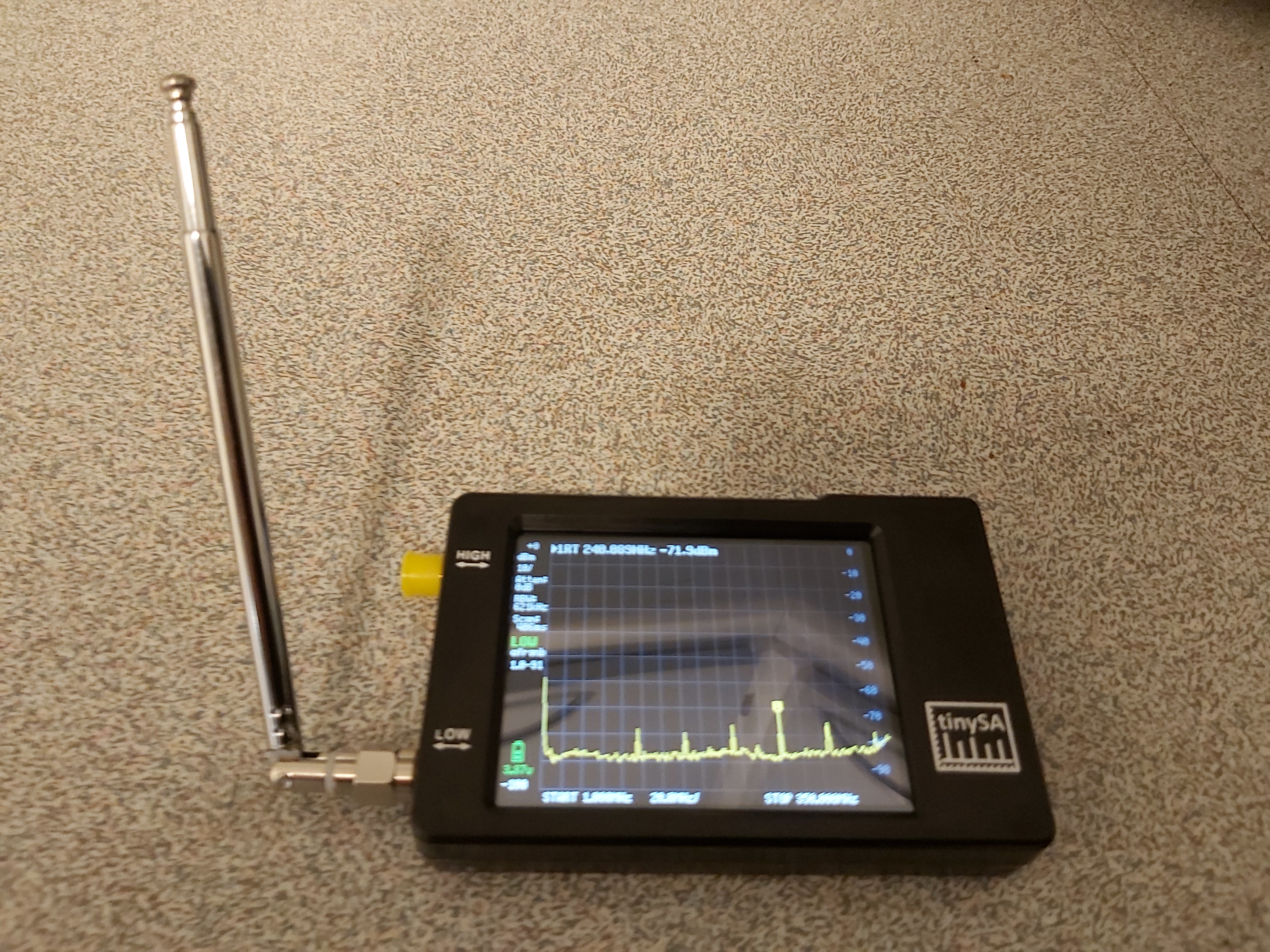A spectrum analyzer measures the magnitude of an input signal versus frequency within the full frequency range of the instrument. The primary use is to measure the power of the spectrum of known and unknown signals. Spectrum analyzers are widely used to measure the frequency response, noise and distortion characteristics of all kinds of radio-frequency (RF) circuitry.
By analyzing the spectra of electrical signals, dominant frequency, power, distortion, harmonics, bandwidth, and other spectral components of a signal can be observed that are not easily detectable in time domain waveforms. These parameters are useful in the characterization of electronic devices, such as wireless transmitters.
Spectrum analyzers used to be very expensive special instruments, but nowadays cheap electronics components and cheap software defined radio hardware has made this tool affordable. TINYSA IS A $49 SPECTRUM ANALYZER. The tinySA is a small spectrum analyzer, primarily intended for 0.1MHz to 350MHz input but can be used with higher frequencies up to 900 MHz.
I got myself tinySA from Bangggood and it seems to be a nice tool for RF testing.

For more details read the PRODUCT REVIEW: THE TINYSA, A SHIRT-POCKET SIZED SPECTRUM ANALYZER and view the following videos.
#535b TinySA Tiny Spectrum Analyzer for $49
TinySA spectrum analyzer 0.1MHz to 350MHz
tinySA first use
tinySA Marker Menu and Marker positioning
#557b TinySA Power Levels (don’t kill your tiny)
tinySA Config and Expert Config Menu
#546b TinySA Measuring Filter with Noise Source
#551b TinySA Wireless Measurements
#563c TinySA RF Sniffing Around the House
553b TinySA Inside the Microwave
#072 tinySA , Just in! Review.
#584b TinySA Ref Level and Attn Setting Hunting
#543b TinySA Measuring Noise Floor
#537c TinySA Don’t use AUTO settings
#551C TinySA On air FM broadcast band modulation
#552b TinySA Measuring with a Coupler
#551b TinySA Wireless Measurements
#538b TinySA Measuring FM Modulation
#550b TinySA Zero Span Mode
Using zero span to look at modulation waveforms
#542b TinySA as an RF Generator
Testing the output modes of the TinySA. Spectral quality and modulations
#561b TinySA Tracking Generator using External Mixer
By using the LO output, a mixer, and fixed frequency oscillator, a tracking generator is created
#562b TinySA Low Frequencies Down to 10 KHz
The TinySA seems to work much lower than the datasheet
#545b TinySA Using Attenuators
#536c TinySA Update: Works well below -30dbm
The TinySA needs to have low input levels to keep mixer harmonics low. If used in this range the performance is quite good
#557b TinySA Power Levels (don’t kill your tiny)
Make sure you don’t over power your TinySA. Check all frequencies and total power.
datasheet: maximum +10dBm input power either port less than 15VDC offset
My recommendation: maximum 0dBm (1mW) input power 0VDC offset
#540b TinySA and NanoVNA Fight
tinySA and NanoVNA measuring each other
#536 TinySA Testing Against an Expensive Spectrum Analyzer (see update for more)
Some initial tests of the TinySA comparing against HP8921a spectrum analyzer. RF signal is sent through a power splitter to both instruments for direct comparison.
The problems I was seeing was do to high input levels. The TinySA will only operate nicely at signal levels below -30dbm.
8 Comments
Tomi Engdahl says:
https://www.tinysa.org/wiki/
Tomi Engdahl says:
https://tinysa.org/wiki/pmwiki.php?n=Main.Buying
Tomi Engdahl says:
https://groups.io/g/tinysa/topic/tinysa_as_bandscope/75168909?p=%2C%2C%2C20%2C0%2C0%2C0%3A%3Arecentpostdate%2Fsticky%2C%2C%2C20%2C2%2C80%2C75168909
Tomi Engdahl says:
New firmware update released for the TinySA. This one adds a feature to step the frequency and level while in LO output. Very useful to step the level in 1 dB or 10 dB steps.
How to update and a link to the firmware site… https://tinysa.org/wiki/pmwiki.php?n=Main.UpdatingTheFirmware
Tomi Engdahl says:
The “tinySA-App” is the only Windows software I know about. The tiny can do more samples with this software than standing alone. You will find a lot of other info too on this page:
https://tinysa.org/wiki/pmwiki.php?n=Main.PCSW
Tomi Engdahl says:
https://www.facebook.com/groups/368777730463838/permalink/812380882770185/
If you are buying a Tiny SA make sure it is from a reputable supplier. The TinySA is trademarked and is NOT open source. There are clones out there that do NOT work. The cloners often use a counterfeit shipping box and are even loading modified firmware to bypass the self test. You can detect a fake by loading the latest firmware and running a self test. Clones will fail because they did not copy the circuit correctly.
There is an updated list of reputable suppliers. A UK supplier has now been removed from this list after selling fakes again. More details below.
https://groups.io/g/tinysa/topic/warning_mirfield_sold_clones/85478885?p=,,,20,0,0,0::recentpostdate%2Fsticky,,,20,2,0,85478885
Tomi Engdahl says:
It’s time to update your TinySA firmware. Lots of nice changes described in this video.
https://m.youtube.com/watch?v=-FIFO5vgGk0
Tomi Engdahl says:
Using only the tinySA Ultra and a small telescopic antenna it is possible to observe various wireless networks. This video demonstrates how you can observe WiFi, 433MHz ISM, Mobile Phone and DECT traffic. [https://www.youtube.com/watch?v=4c4oNJRnPrc](https://www.youtube.com/watch?v=4c4oNJRnPrc)